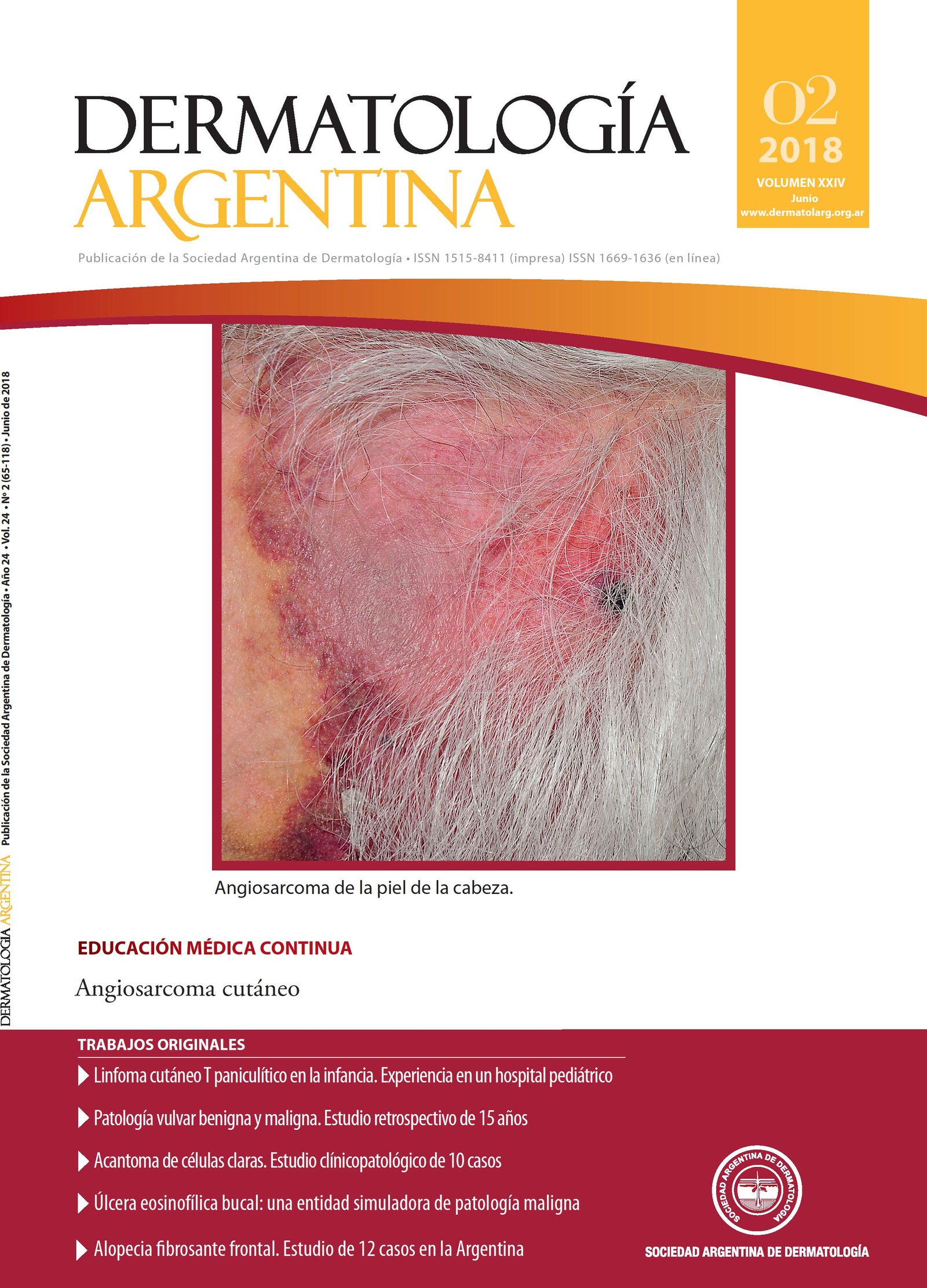Subcutaneous panniculitis-like T-cell lymphoma in children. Experience in a pediatric hospital
Keywords:
primary cutaneous lymphoma, subcutaneous panniculitis-like T-cell lymphoma, childrenAbstract
76Dermatología Argentina Vol. 24 Nº 2 Junio de 2018: 76-80 ISSN 1515-8411 (impresa) ISSN 1669-1636 (en línea)Linfoma cutáneo T paniculítico en la infancia. Experiencia en un hospital pediátricoSubcutaneous panniculitis-like T-cell lymphoma (SPTCL) is a rare entity that preferentially involves the subcutaneous tissue and represents < 1% of cutaneous T-cell lymphomas.SPTCL has no predilection of gender and could affect people of all ages but is rarely seen in children.Patients present subcutaneous nodules that affect extremities and trunk but may compromise other locations.Histologically we may observe a diffuse subcutaneous tissue infiltration by atypical lymphocytes arranged around the adipocytes, abundant vacuolated-looking macrophages, fat necrosis and karyorrhexis. Immunohistochemistry and genetic studies are important for diagnosis and prognosis.We present 6 patients diagnosed with SPTCL admitted to our pediatric hospital (Hospital Prof. Dr. Juan Pedro Garrahan) between August 1988 and April 2017.
References
I. González CL, Medeiros LJ, Braziel RM, Jaffe ES. T-cell lymphoma involving subcutaneous tissue: a clinicopathologic entity commonly associated with hemophagocytic syndrome. Am J Surg Pathol 1991;15:17-27.
II. Ceppi F, Pope E, Ngan B, Abla O. Primary cutaneous lymphomas in children and adolescents. Pediatr Blood Cancer 2016;63:1886-1894.
III. Go RS, Wester SM. Immunophenotypic and molecular features, clinical outcomes, treatments, and prognostic factors associated with subcutaneous panniculitis-like T-cell lymphoma: a systematic analysis of 156 patients reported in the literature. Cancer 2004;101:1404-1413.
IV. Campo E, Swerdlow SH, Harris NL, Pileri S, et ál. The 2008 WHO classification of lymphoid neoplasms and beyond: evolving concepts and practical applications. Blood 2011;117:5019-5032.
V. Abeldaño A, Azcune R. Consenso Linfomas Cutáneos Primarios. [en línea], Dermatol Argent 2007;13(1). <http://www.dermatolarg.org.ar/index.php/dermatolarg/article/view/260/115>, [consulta: 20 de octubre de 2017], ISSN 1669-1636.
VI. Huppmann AR, Xi L, Raffeld M, Pittaluga S, et ál. Subcutaneous panniculitis-like T-cell lymphoma in the pediatric age group: A lymphoma of low malignant potential. Pediatr Blood Cancer 2013;60:1165-1170.
VII. Willemze R, Jansen P, Cerroni L, Berti E, et ál. Subcutaneous panniculitis-like T-cell lymphoma: definition, classification, and prognostic factors: an EORTC cutaneous lymphoma group study of 83 cases. Blood 2008;111:838-845.
VIII. Kim YH, Willemze R, Pimpinelli N, Whittaker S, et ál. TNM classification system for primary cutaneous lymphomas other than mycosisfungoides and Sezary syndrome: a proposal of the International Society for Cutaneous Lymphomas (ISCL) and the Cutaneous Lymphoma Task Force of the European Organization for Research and Treatment of Cancer (EORTC). Blood 2007;110:479-484.
IX. Groves FD, Linet MS, Travis LB, Devesa SS. Cancer surveillance series: non-Hodgkin’s lymphoma incidence by histologic subtype in the United States from 1978 through 1995. J Natl Cancer Inst 2000;92:1240-1251.
X. Hu ZL, Sang H, Deng L, Li Z. Subcutaneous panniculitis-like T-cell lymphoma in children: a review of the literature. Pediatr Dermatol 2015;32:526-532.
XI. Gupta V, Arava S, Bakhshi S, Vashisht KR, et ál. Subcutaneous panniculitis-like T-cell lymphoma with hemophagocytic syndrome in a child. Pediatr Dermatol 2016;33:e72-e76.
XII. Johnston EE, LeBlanc RE, Kim J, Chung J, et ál. Subcutaneous panniculitis-like T-cell lymphoma: pediatric case series demonstrating heterogeneous presentation and option for watchful waiting. Pediatr Blood Cancer 2015;62:2025-2028.
XIII. Michonneau D, Petrella T, Ortonne N, Ingen-Housz-Oro S, et ál. Subcutaneous panniculitis-like T-cell lymphoma: immunosuppressive drugs induce better response than polychemotherapy. Acta Derm Venereol 2017;97:358-364.
Downloads
Published
Issue
Section
License
Copyright (c) 2018 Argentine Society of Dermatology

This work is licensed under a Creative Commons Attribution-NonCommercial-NoDerivatives 4.0 International License.
El/los autor/es tranfieren todos los derechos de autor del manuscrito arriba mencionado a Dermatología Argentina en el caso de que el trabajo sea publicado. El/los autor/es declaran que el artículo es original, que no infringe ningún derecho de propiedad intelectual u otros derechos de terceros, que no se encuentra bajo consideración de otra revista y que no ha sido previamente publicado.
Le solicitamos haga click aquí para imprimir, firmar y enviar por correo postal la transferencia de los derechos de autor











